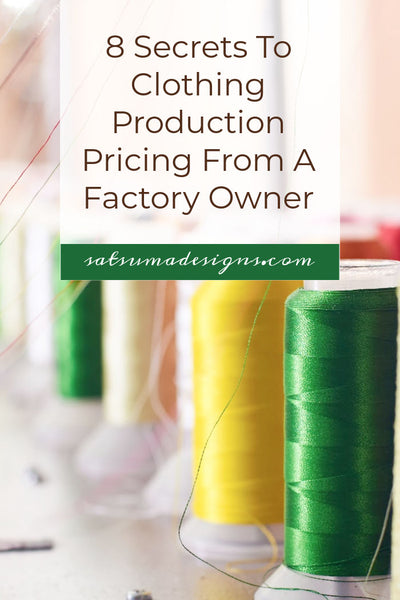How To Pay To Start a Fashion Company
How To Pay To Start a Fashion Company
Please note: I make no guarantee of financial success by sharing this information. Your success is yours alone. I come to this work with 20 years of industry experience and can help you grow.
All dreams that become reality have one thing in common. Hard work.
The first step in starting any fashion company is determining how you're going to pay for it. My guide on how to pay to start a fashion company has a tested set of recommendations to get your from dream phase to customer ready.
Let's dive in to how to fund your fashion company and create a sustainable brand.
Feeling comfortable asking for startup funding begins by being well-prepared and confident in your business. Start at the beginning.
You'll need a solid fashion company business plan that lays out every strategy and tactic for launch and growth. Plan to use existing fashion companies as examples in your plan to show how others have done it.
Investors whether personal contacts or commercial lenders need to see that you have done thorough research and understand the mechanics of the fashion market.
Create a Comprehensive Business Plan
Your business plan should cover all aspects of your fashion brand, from market analysis to financial projections.
This 'living' document (because it can change over time) serves as a roadmap for your business and instills confidence in potential investors or lenders.
Develop a Strong Executive Summary
This is a snapshot of your business plan, providing a quick overview of your brand, its mission, and financial projections. Make it compelling to grab the attention of potential investors.
Craft a Marketing Plan
Showcase your understanding of your target market, competition, and how you plan to position and promote your fashion brand.
Do this by tracking competitors on social media. Follow similar brands, watch how and what their customers comment on and note this for your fashion company development.
A well-thought-out marketing plan demonstrates your commitment to driving sales and building brand awareness.
Outline a Sales Strategy
Detail your sales approach, including pricing strategies, distribution channels, and sales projections.
Most fashion companies positioned for growth should have a direct-to-consumer (DTC) and wholesale strategy planned.
Optimizing wholesale margins will take careful planning on design elements to ensure that you can manufacture affordably and ethically.
Choose a U.S. sewing factory that cares about living wages and a circular consumer cycle that reduces or eliminates waste and produces high-quality products that last.
This helps investors understand how you plan to generate revenue and achieve financial success.
Use My Fashion Business Daily Planner
Track plans and progress with my Fashion Business Daily Planner available on Amazon for $18.95. I have designed this planner to serve the needs of fashion brands from startup through growth and scaling phases.
Production and Operations Plan
Clearly outline how your fashion products will be produced, including the supply chain, manufacturing processes, and quality control measures.
A well-organized operations plan reflects your ability to deliver products efficiently.
How To Pay To Start a Fashion Company
Seeking financing is a natural and necessary part of business growth.
Confidence comes from thorough preparation and a clear vision for your fashion brand.
By presenting a well-structured business plan and utilizing the right resources, you'll create a compelling case for potential investors or lenders.
Here are the seven best ways to finance a fashion brand across various budgets.
Bootstrap to Start Small and Grow Steadily
Bootstrapping involves using your own savings or revenue generated by the business to fund its growth.
It's a viable option for those with limited initial capital or those who want to maintain full control. To feel comfortable with this approach, ensure you have a well-thought-out business plan detailing your financial projections and a clear strategy for sustainable growth.
Start out by making product in-house and selling through in-person events. TEST your products by asking for feedback on sizing, pricing, value, durability and any other metrics you determine to be important to your product development.
Plan to spend 6-12 months in this learning and development phase.
Crowdfund to Leverage Community Support
Crowdfunding platforms like Kickstarter or Indiegogo can be excellent options for raising funds while engaging directly with potential customers.
This method is particularly effective for fashion brands that have a unique story or product. When seeking funds through crowdfunding, be sure to present a compelling product description with features and benefits along with and a transparent breakdown of how the funds will be used.
You MUST follow through on your promises to these early supporters.
Small Business Loans to Tap into Established Financial Institutions
Traditional lending from banks or credit unions remains a reliable option. You'll need to have solid financial projections and a polished business plan to attract attention of commercial lenders.
Highlighting your understanding of the market, competition, and potential risks will help make your case stronger.
I recommend approaching local credit unions that are uniquely connected to the communities in which they serve. Often, credit unions will have small business start up program that can be both affordable and come with technical support in the form of industry connections and support.
Investment from Friends and Family for Trust and Collaboration
Seeking support from friends and family can provide a significant boost to your fashion brand.
It's critical to approach this avenue professionally and carefully, treating it like any other business transaction.
Clearly communicate your business vision, plans, and potential returns. Create formal agreements to avoid misunderstandings and ensure trust and transparency.
You MUST seriously consider paying interest on your family and friends' investment along with a timeline for payment. This can be a long-term program, but to preserve the relationships, it's essential to have a payback plan in place if the fashion company tanks.
Angel Investors or Venture Capital to Create Strategic Partnerships
For more substantial financing needs, consider seeking investment from angel investors or venture capitalists.
These investors are often looking for high-growth potential and can provide not just funds but also valuable guidance. To attract these investors, have a polished business plan that showcases your market understanding, competitive edge, and scalability.
Be prepared to present a detailed sales plan and marketing strategy, demonstrating your ability to reach and retain customers.
Grants and Competitions
Tap into Non-Profit and Industry Support
Explore grants and competitions offered by non-profit organizations, industry associations, or government bodies that support emerging businesses.
Many organizations provide funding or resources to businesses in specific sectors, including fashion. Look for opportunities that align with your brand's mission and values.
When applying, emphasize your brand's unique selling points and the positive impact it could have on the industry or community. Before applying for grants and this type of support, plan to have a year or more of sales data to show a stong case for funding.
To feel more at ease in pursuing grants or entering competitions, focus on articulating your brand's social and environmental responsibility.
Clearly outline how your fashion brand contributes to positive change or addresses a gap in the market.
This approach not only enhances your chances of securing funding but also aligns your brand with broader industry goals.
Online Lending Platforms to Optimize Growth in the Digital Financial Landscape
Explore online lending platforms that cater specifically to small businesses and startups.
These platforms offer a streamlined application process and quick access to funds.
Peer-to-peer lending or alternative financing options can be especially beneficial for fashion entrepreneurs looking for a flexible and accessible funding source.
To navigate online lending, be sure to research reputable platforms with transparent terms and reasonable interest rates.
Present a clear case for your fashion brand's viability, including your sales and marketing strategy. Emphasize how the funds will be utilized for growth and how the lender will benefit from the success of your brand.
Feeling comfortable with online lending involves understanding the terms, interest rates, and repayment schedules.
Carefully review the terms offered by different platforms and choose the one that aligns with your financial goals and capabilities.
Every fashion company financing option comes with its own set of considerations and potential benefits as well as risks.
Assess your business needs, budget constraints, and long-term goals to determine the most suitable financing strategy for your fashion brand. Combining multiple funding sources may also be a viable approach to diversify your financial support and mitigate risks.
Let’s Be Social!
👉🔗 Follow me on Instagram for more intel or Pinterest where I share what's working for me in business and delighting my creative senses!







